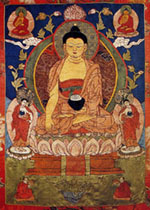
In this unit we will read a biography of the Buddha and look at a variety of artistic retellings of his life so that we can write and illustrate our own life of the Buddha. In addition, we will continue to answer questions we posed when we read Jataka tales: What makes a hero heroic? Are religious heroes different from other heroes? What qualities do religious heroes demonstrate? As we begin to write and illustrate our own biography of the Buddha, we will need to answer new questions: What are the different elements that constitute a biography? What information should you include and how should you collect it? How should you organize and present what you learn? How has the story been told before? Should you retell it differently?
worth remembering?
Journal
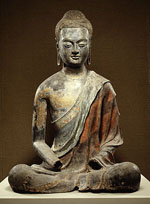
The information we have about the Buddha's life comes from several major sources: 1) the Tipitaka or "Three Baskets," records of the Buddha's sermons and teachings which were written down about a hundred years after the Buddha's death; 2) works that were composed by using the Tipitaka and legends surrounding the Buddha's life and teachings, and 3) archaeological findings. Early texts were in various North Indian languages: Pali, Sanskrit, or one of the Prakrits. As Buddhism spread throughout Asia, texts were translated, older texts were lost, and new translations and images appeared in Chinese and Tibetan to replace them. Often, as Buddhism moved from place to place and language to language, the story of the Buddha's life changed to match new cultures and customs.
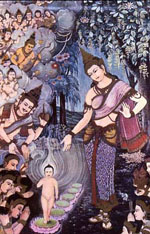
Will the Real Buddha please stand up?
Journal

Journal
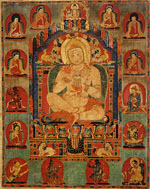
Many of the sources that are available are visual representations of the Buddha: murals, paintings, thangkas, statues. Before we start studying them, we will spend several days learning to look at art, describe art, and ask questions about art to deepen our understanding of it. We will practice what we learn with a gallery walk in class and by viewing exhibits from the Metropolitan Museum of Art, www.metmuseum.org. For instance, when we visit the Metropolitan Museum of Art web site, you will need to choose one work of Asian art, observe it closely, and carefully describe it so that someone who has never seen it can find it in the gallery.
Looking at Asian Art
Homework
Journal
For homework, visit Himalayan
Art . View "Buddha's Challenge." Take notes, draw pictures,
and write your observations in your journal. Then visit the Nova
exhibit on Tibet. View
"Deciphering Buddha Imagery." Take notes on the important features
of the Buddha's figure and his different mudras. Then read "Creating
a Wall Painting." As you read, answer the following four questions:
1) What four of the Buddha's traits does the portrait show? 2) what mudra
is he using? 3) How did artists obtain pigments for blue, red, yellow,
and white? and
4) What does each color symbolize?
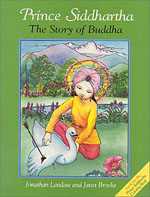
Now that we have more historical background and strategies
to understand artistic depictions of the Buddha and his life, we can start
reading Prince Siddhartha: The Story of the Buddha.
Reading Assignments


Now that we know the story our task is to retell and illustrate
the the Buddha's life so that it is appropriate for second through eighth
grade audiences. We need to discuss the information we have and our understanding
of the story and then assess what is crucial to include in a biography.
We will need to think as writers and illustrators. We must decide what
elements of the story of the Buddha's life make it dramatic and religiously
compelling. We will need to outline a vision of his life we believe is
faithful, dramatic, and spiritually meaningful. And we will need to plan
illustrations for each episode of his life. In short, we need to make
a story board.
Project
Your final project is to create an illustration and textual narration
of one episode from the Buddha's life. The aim of the project is to create
an illustrated mural of the Buddha's life that can be viewed, read, and
understood by students from the fourth through eighth grades.
Use the thumbnail pictures on this page and works on in Resources section
as examples of illustrations.
The episodes we depict will depend on our final reading of the story and
the decisions we make about organizing and dramatizing events in the Buddha's
life. The illustration style will depend on a class decision.
Your project should satisfy the following requirements:
1) Your illustration should be 36" x 48", 2) the illustration
of each episode should represent the main characters and events in that
episode, 3) it should contain important traditional symbols, 4) the illustration
should be thoughtfully composed, 5) it should be hand-drawn, stenciled,
electronically composed in a graphic arts program, or composed as a collage,
6) the illustration should be appropriately sized, carefully drawn, and
neatly colored, 7) it should contain a narrative passage of 100 to 200
words retelling the episode in your own words, and 8) your retelling should
be dramatic, concisely written, and carefully edited.
Prince Siddhartha: The Story of Buddha. Second Edition. Jonathan
Landaw. Sommerville, MA: Wisdom Publications, 2003.
Prince Siddhartha Coloring Book. Jonathan Landaw. Sommerville, MA:
Wisdom Publications, 1996
The Art of Tibet. Robert Fisher. London: Thames and Hudson, 1997.
Tibetan Thangka Painting. David and Janice Jackson. Ithaca, NY:
Snow Lion Publications, 1984.
http://www.askasia.org/AsianArt
http://www.exoticindiaart.com/article/lifeofbuddha
www.metmuseum.org
http://www.pbs.org/wgbh/nova/tibet